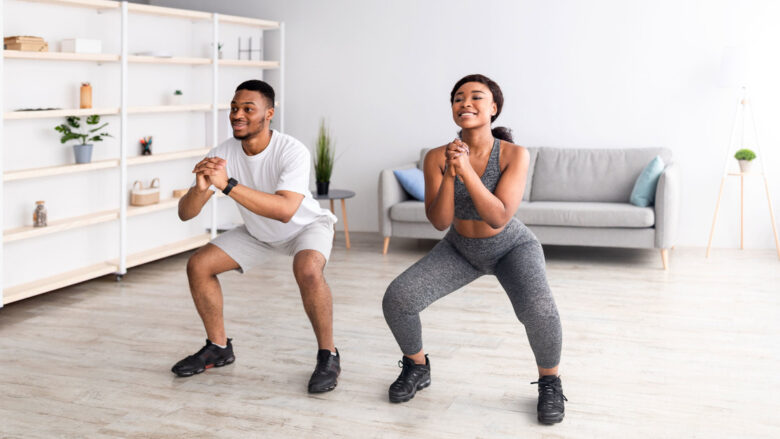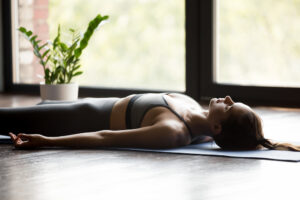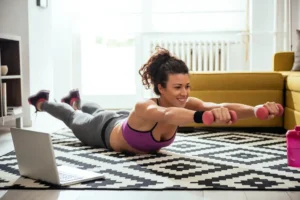People often forget that flexibility is one of the most important aspects of exercise. Mobility refers to the ability of a joint to move through its full range of motion. Flexibility refers to the extension of a muscle. Good flexibility makes daily activities easier, prevents stiffness, reduces the risk of injury, and improves athletic performance. These days, people often experience limited mobility due to sitting at a desk for long periods of time or using electronic devices.
Simple flexibility exercises not only counter this limitation but also improve posture and energize the body. The positive news is that you don’t need a gym or special equipment to improve your flexibility. A few simple exercises performed daily can make a big difference. Let’s look at a few simple exercises that anyone can do at home to improve their flexibility.
Understanding the Importance of Flexibility:
Flexibility is more than just being able to bend and stretch. It means being able to move with strength, control, and ease. Limited mobility can make even simple tasks like walking, bending, or climbing stairs difficult. When you can’t move easily, you increase muscle tension, poor posture, and the risk of falls or injuries. Maintaining mobility is especially important for athletes, but it’s also crucial for people of all ages. Improving mobility helps relieve stiffness from prolonged sitting and improves blood circulation throughout your body. Furthermore, being able to move easily contributes to joint health and helps maintain joint health and flexibility as you age. Mobility helps you get in better shape and improves your daily life.
Stretch with Ease for More Flexibility:
One of the best ways to improve your flexibility is stretching. Stretching lengthens muscles and improves circulation. Dynamic stretches with controlled movements are most effective as a warm-up and workout preparation. Simple exercises like arm circles, leg swings, and torso rotations can help loosen joints and muscles, allowing you to move more easily. Holding a position for a period of time is another form of static stretching that relaxes you and improves your flexibility, helping you maintain mobility. To maintain your flexibility, it’s important to stretch regularly, preferably after a workout or in the morning. Daily stretching helps maintain balance, improves range of motion, and reduces the risk of long-term injuries due to muscle strain.
Strength Training for Improved Flexibility:
Strength training not only builds strength but also helps you move better. Strong muscles provide more support for joints, allowing you to move more smoothly and experience less stress. Exercises like squats, lunges, and push-ups not only build strength but also help improve joint mobility. For example, squats help improve hip and ankle flexibility, while overhead presses improve shoulder mobility. For optimal results, combine resistance training with light weights or resistance bands with mobility-focused exercises. Stronger muscles make it easier to maintain balance, rhythm, and joint stability. All of this helps you move more easily. When you combine strength training with stretching exercises, your body becomes more stable, and you can move more easily.
Yoga and Improving Your Flexibility:
Yoga focuses on strength, balance, stretching, and breathing, making it one of the best ways to improve your mobility. Many yoga exercises focus on loosening tight hips, strengthening the spine, and improving joint function. Stretches like downward dog, child’s pose, and warrior pose help stretch muscles and restore normal movement patterns. Conscious breathing is another important component of yoga. It helps the body release tension and relax. Unlike conventional stretching exercises, yoga trains both the mind and the body, making it a comprehensive way to improve flexibility. Regular yoga practice not only improves physical flexibility but also enhances mental focus, reduces stress, and offers more information about your health.
Movements That Benefit Daily Life:
Flexibility training is most effective when performed as if it were a real movement. Functional exercises, designed to help you perform daily activities, are very beneficial for improving your flexibility. The body bends, twists, extends, and lifts constantly. Functional flexibility training helps you perform these movements more easily. For example, hip hinge exercises make bending easier, and rotational extensions make twisting and turning easier. Regular practice of these exercises can improve your movement patterns, loosen your joints, and make physical activity easier and safer. Functional movement training is important for older adults because it helps them maintain independence and reduces the risk of falls. Flexibility training that focuses on movements that help with daily life is useful, meaningful, and long-lasting.
Conclusion:
Flexibility is an important part of fitness because it helps the body move easily and powerfully and maintain balance. Despite its significant impact on daily life, people often overlook flexibility training in favor of strength training or exercise. Simple activities like yoga, stretching, and functional exercises can make your joints healthier and more flexible and improve your overall movement patterns. The beauty of mobility training is that it doesn’t require expensive equipment or a lot of time—just a few minutes a day can yield significant results. By prioritizing mobility, you improve your ability to move and prevent stiffness, injuries, or discomfort. Improving your mobility is an investment in a healthier, more active, and pain-free life for everyone, young and old. Start gradually and stick to your daily routine to see how your daily life changes as you incorporate mobility training.
FAQs:
1. What is the difference between being able to move and being able to bend?
Flexibility means that muscles are long enough to stretch. Flexibility means that joints can reach their full range of motion.
2. How often should I do mobility training?
Doing mobility exercises daily, even if only for 10-15 minutes, can keep joints healthy and prevent pain.
3. Do activities that improve mobility help relieve pain?
Yes, being able to move more easily can help loosen stiff joints and muscles, relieving pain and stiffness.
4. Is yoga enough for mobility?
While yoga alone is great for improving mobility, combining it with strength training and functional exercises yields the best results.
5. Do I need special equipment for mobility exercises?
Most mobility exercises don’t require special equipment, but resistance bands or light weights can make them more effective.




